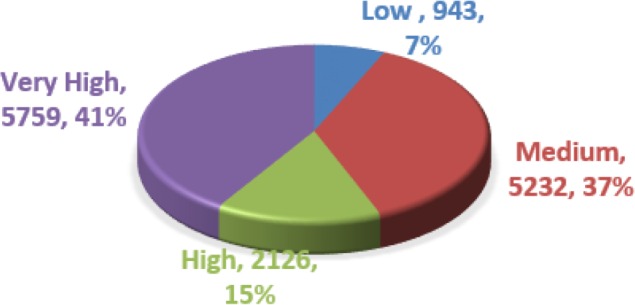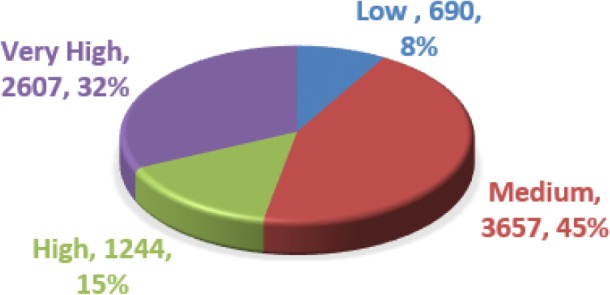Dear Editor-in-Chief
In the recent years, incidence and mortality of cancer, has been increasing in the world (1). Therefore, cancer is one of the major public health problems in many countries (2).
The incidence of cancer is different in various countries. Geographical differences in the cancer incidence may be due to different distribution of cancer risk factors in the world. Many of risk factor causes cancer, a risk factor for incidence and mortality of cancer is related to development, so that, previous studies have examined the role of indicators associated with development such as Human Development Index(HDI) with the incidence and mortality of some cancers (3). There are significant differences between developed and developing countries according to prevalence of cancers (4).
One of these indicators is HDI, this index is a number between zero and one. According to HDI, countries in the world are divided into four categories: Countries with very high HDI (HDI> = 0.9), countries with a high HDI (HDI> = 0.8), Medium HDI countries (0.8> HDI> 0.5), and countries with a low HDI (HDI <= 0.5), the index proposed by UNDP in 1990 as an indicator of comparison of countries in three human aspects (5).
It is possible to find significant differences between developed and developing countries according to prevalence of cancers. The aim of this study was to investigate the relationship between incidence and mortality of all cancers with human development index (HDI) in 2012.
In this study, we extracted data related to all cancers excl. non-melanoma skin cancer from International Agency for Research on Cancer (IARC) database. In this project, cancer incidence and mortality are calculated and recorded for 184 countries (6). We compared the incidence and mortality all cancers excl. non-melanoma skin cancer in countries with difference HDI.
In 2012 in world cancer incidence in high human development index countries (41%) and mortality rate in this countries is (32%), whereas cancer incidence in medium development index countries consist 37% of cancers occurring in the world, but 45 percent of death event in this countries.
Cancer incidence in developed countries is high but mortality rate in developing countries is high (Fig. 1, 2). A positive relationship between HDI and the incidence of cancers and negative relationship between HDI and the mortality of cancers and HDI is reported.
Fig. 1:

All cancers excl. non-melanoma skin cancer: Both sexes estimated number of cases (* 1000)
Fig. 2:

All cancers excl. non-melanoma skin cancer: Both sexes estimated number of death (* 1000)
With increasing income and improving living standards in developing countries, the incidence of some cancer increases. This may be due to longer life, higher exposure to risk factors, eating more fatty foods and obesity, and lower pregnancy rates (7).
High incidence rates for some cancers in developed countries may reflect the detection method is through screening and imaging techniques. Early detection reduces the mortality rate in these countries (8), in high-income countries, taking advantage of better diagnostic methods significantly is different from other countries (9). Lower survival in cancer patients more related with the lack of access to quality care, not biological differences between tumors (10).
Right now in developing nations, diagnostic information cannot be properly completed (8).
In conclusion cancers in low and moderate HDI countries is increasing, so it is necessary to be planning for the control and prevention of cancers as a priority for health policy makers in these countries, also further epidemiological studies into the etiology and early detection are essential.
Acknowledgement
The authors declare that there is no conflict of interests.
References
- 1. Rafiemanesh H, Mehtarpour M, Khani F, Hesami SM, Shamlou R, Towhidi F, et al. (2016). Epidemiology, incidence and mortality of lung cancer and their relationship with the development index in the world. J Thorac Dis, 8( 6): 1094–1102. [DOI] [PMC free article] [PubMed] [Google Scholar]
- 2. Bray F, Jemal A, Grey N, Ferlay J, Forman D. (2012). Global cancer transitions according to the Human Development Index (2008–2030): a population-based study. Lancet Oncol, 13( 8): 790–801. [DOI] [PubMed] [Google Scholar]
- 3. Gonzaga CM, Freitas-Junior R, Curado MP, Sousa AL, Souza-Neto JA, Souza MR. (2015). Temporal trends in female breast cancer mortality in Brazil and correlations with social inequalities: ecological time-series study. BMC Public Health, 15: 96. [DOI] [PMC free article] [PubMed] [Google Scholar]
- 4. Pakzad R, Mohammadian-Hafshejani A, Khosravi B, Soltani S, Pakzad I, Mohammadian M, et al. (2016). The incidence and mortality of esophageal cancer and their relationship to development in Asia. Ann Transl Med, 4( 2): 29. [DOI] [PMC free article] [PubMed] [Google Scholar]
- 5. UNDP (2014). Human Development Report: UNDP; [July, 2014]. http://www.undp.org/content/undp/en/home/presscenter/events/2014/july/HDR2014.html . [Google Scholar]
- 6. Ferlay JSI, Ervik M, Dikshit R, Eser S, Mathers C, Rebelo M, Parkin DM, Forman D, Bray F. (2012). GLOBOCAN 2012 v1.0, Cancer Incidence and Mortality Worldwide: IARC CancerBase No. 11 [Internet]. Lyon, France : : International Agency for Research on Cancer 2013 ; . http://globocan.iarc.fr . [Google Scholar]
- 7. WHO (2013). The breast cancer conundrum. Bulletin of the World Health Organization, 91 , http://www.who.int/bulletin/volumes/91/9/13-020913/en/ . [DOI] [PMC free article] [PubMed]
- 8. Jemal A, Center MM, DeSantis C, Ward EM. (2010). Global patterns of cancer incidence and mortality rates and trends. Cancer Epidemiol Biomarkers Prev, 19( 8): 1893–907. [DOI] [PubMed] [Google Scholar]
- 9. Abbastabar H, Hamidifard P, Roustazadeh A, Mousavi SH, Mohseni S, Sepandi M, et al. (2013). Relationships between Breast Cancer and Common Non-Communicable Disease Risk Factors: an Ecological Study. Asian Pac J Cancer Prev; 14 ( 9 ): 5123 – 5 . [DOI] [PubMed] [Google Scholar]
- 10. Bradley CJ, Given CW, Roberts C. (2001). Disparities in cancer diagnosis and survival. Cancer, 91( 1): 178–88. [DOI] [PubMed] [Google Scholar]


